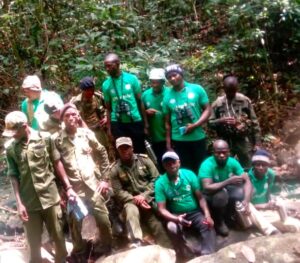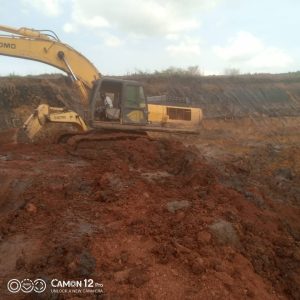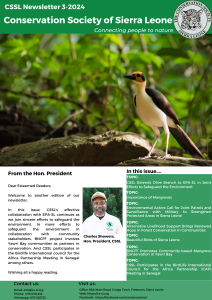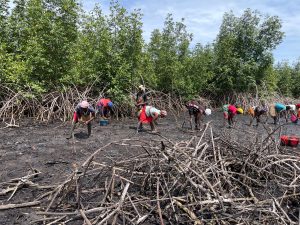 The Gola Rainforest National Park’s satellite community forest landscape, including the Kambui Hills Forest Reserve, which covers an area of nearly 700 square kilometres, is the largest remains of the Upper Guinean Tropical Rainforest in Sierra Leone. The forest, which was under threat from poaching, logging, hunting, fishing, and farming, has high conservation value species, including the White-necked Picathartes, Pygmy Hippo, the Jentink’s Duiker and the Western Chimpanzee suffered unprecedented anthropogenic activities that had negative impacts on the ecosystem, which, had the potential to degenerate the community forest landscape and exposed inhabitants to serious environmental consequences.
The Gola Rainforest National Park’s satellite community forest landscape, including the Kambui Hills Forest Reserve, which covers an area of nearly 700 square kilometres, is the largest remains of the Upper Guinean Tropical Rainforest in Sierra Leone. The forest, which was under threat from poaching, logging, hunting, fishing, and farming, has high conservation value species, including the White-necked Picathartes, Pygmy Hippo, the Jentink’s Duiker and the Western Chimpanzee suffered unprecedented anthropogenic activities that had negative impacts on the ecosystem, which, had the potential to degenerate the community forest landscape and exposed inhabitants to serious environmental consequences.
Kambui and Gola are part of the wider Gola Rainforest landscape in the region threatened by deforestation. Protecting this ecosystem is critical in preserving the integrity of the Gola Rainforest, which the support Program for the Preservation of Forest Ecosystem in West Africa (PAPFor), funded by the European Commission, has been working to ensure.
A major challenge faced in protecting the forest was ensuring that local communities – the custodians of the forest, play a key role in conservation activities through community forestry. Community forestry involves the participation and collaboration of various stakeholders, including community, government and non-governmental organisations. The level of involvement of each group depends on the specific community forest project and the management system in use.
In the Eastern Province of Sierra Leone, Birdlife partner, the Conservation Society of Sierra Leone (CSSL) has been working with six chiefdoms since 2021 to establish conservation zones. The governance structures, including Community Forest Co-Management Committees (CFMCs) have successfully been established in the targeted communities. Separate Memorandums of Understanding (MoUs) were signed with the six chiefdoms to establish five conservation zones in the Gola Landscape and one in the Kambui Landscape. The forest reserve created are in: Naiati, Lukweh, Gayayeyei, Gidorma, Mahungbeh, and Kambui communities in Barri, Gaura, Makpele, Tunkia and Nongowa chiefdoms respectively.
However, the principal threats to the conservation areas, including logging, hunting, poaching and farming, were still evident and further actions were needed to save the ecosystem. The conservation areas lacked eco-guards and forest monitors. There was fear of a resurgence of illegal activities due to the absence of a mechanism to patrol and monitor.
To enhance effective and efficient management of the Kambui Hills Forest Reserve, 10 eco-guards trained and supported by CSSL have been patrolling and bio-monitoring the Protected Areas (PAs). Additionally, 14 forest monitors trained and supported by CSSL are patrolling the seven chiefdoms in the Gola landscape.
“The only way to enhance sustainable biodiversity conservation is to ensure that community stakeholders take the lead in the process”, said Patrick Dauda, CSSL’s Land Use Planning, Community Forestry and Co-Management Coordinator, one of the key staff spearheading the project.
Trained in forest patrolling and biodiversity monitoring, the eco-guards, who conduct regular patrols with rangers of the National Protected Area Authority (NPAA), collect data on wildlife and illegal human activities in the PAs, and create awareness on the danger of destroying the ecosystem.
Deployment of eco-guards enhances the efficiency of the protection and surveillance of the reserve. Further, it enhances the protection of the biodiversity and ecosystem of the landscape.
“The eco-guards and forest monitors have been trained to undertake patrolling missions to support CSSL to detect and prevent threats to the PAs such as hunting, mining and farming with the objective to keep the ecosystem from destruction. They also raise awareness about the danger of certain human activities to the ecosystem”, Dauda added.
The deployment of eco-guards and forest monitors, yet in small numbers, has proven to be an effective tool, together with the CFMCs, in curbing activities that are harmful to the ecosystem. In addition to drastically reducing poaching levels, farming, hunting and mining in Gola and Kambui, their work has compelled inhabitants of the area to divert their sources of livelihood to other activities, including the harvesting of non-timber forest products and involvement into agribusiness.
“Since the committees were established and eco-guards started working, people have stopped using the community forest for farming, mining, hunting. Our people are going by the law. The eco-guards here know the entire forest, and they are doing very well,” Kadi Bawo, Town Chief of Boma in Barri chiefdom said.
Mohammed S. Sesay has been working as an eco-guard in the Kambui Hills Reserve since 2022 and has dedicated the past three years to protecting the ecosystem. Mohammed feels it is a duty to protect the forest. He is very proud to be on the frontlines of helping to maintain the integrity of the Kambui Hills Reserve.
“I consider this as a responsibility. We must protect this forest for our generation and generations yet unborn. When we destroy the forest, we destroy ourselves. Since we started protecting our forest, the weather here has been favourable. We also now have clean water in our communities. This is a duty, and I am dedicated to it”, Sesay concluded.
The EU PAPFor Programme is supported by the European Commission
By Mambu James Kpargoi



